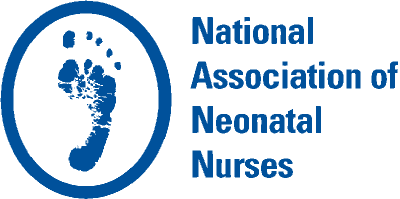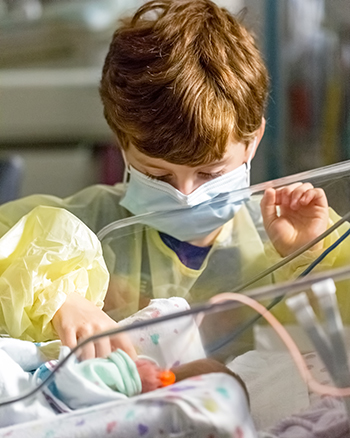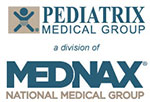Special Interest Group Update
In each issue, one of NANN’s special interest groups will share information in their area of focus.
"What About Me?”: Sibling Support in the NICU
Kristen Ehrhardt, BSN RN; Elizabeth Harwood, BSN RN; Courtney Lopiano, BSN RN; Cassidy Norton, BSN RN. Connecticut Children’s NICU, Hartford, CT.
Alarms, lights, plastic boxes, machines, tubes— imagine being a sibling, excited to meet your baby brother or sister for the first time, and entering a Neonatal Intensive Care Unit (NICU). The attention is all on this baby, and you, the sibling, are scared, forgotten, and confused. Your normal routines are disrupted, and your family dynamic has changed.
This scenario frequently happens in NICUs across the country. Policies and procedures on sibling visitation can range from encouraging sibling visitation to limiting or completely restricting of sibling visitation. Many NICUs lack resources to support siblings as they transition into the world of the NICU.
The responsibility to acclimate and educate siblings may fall on NICU parents, who are already experiencing significant stress. With an evolving culture of family-centered care, supporting siblings through this transition is vital (Morrison & Gullon-Rivera, 2017).
At Connecticut Children’s in Hartford, Connecticut, a group of new graduate nurse residents quickly realized the need for a structured sibling support program and decided to make a change. Armed with information from clinical practice, the literature, and parents, these nurse residents created an evidence-based sibling support educational program co-lead by NICU nurses and a Child Life Specialist (CLS).
Research supports the concept of sibling support (Andgrade, 1998; Morrison & Gullon-Rivera, 2017) with an emphasis on the importance of an interprofessional approach (Levick et al., 2010; Morrison & Gullon-Rivera, 2017). According to the American Academy of Pediatrics, utilization of Child Life Services is a benchmark of family-centered pediatric care and excellence (American Academy of Pediatrics, 2014). The research demonstrates that siblings who visit NICUs with sibling support programs and exposure to a CLS exhibit fewer negative behaviors, have improved sibling bonding, and are better informed about their sibling’s condition (Andrade, 1998). A recent study identified that gaps in care regarding sibling support and a lack of NICU preparation for siblings was highly dissatisfying for NICU parents (Hagen, Iversen, Nesset, Orner, & Svindseth, 2019). There are limited studies on how to implement structured NICU sibling programs. The sparse amount of data on this topic reflects a limited awareness in the practice community about the need for sibling support programs.
Several factors can hinder the implementation of a sibling support program. First, sibling visitation bears a significant concern of infection risk in the units. Although studies have shown that sibling visitation does not increase the frequency of infection (Horikoshi et al., 2018), some NICUs have very restricted sibling visitation policies, especially during the peak influenza winter months. Other common barriers to establishing a sibling support program include staffing and funding (Newton, 2009).
Although these nurse residents faced similar barriers identified above, with the support of leadership, hospital, and unit-based resources, the nurse residents designed an evidence-based program supportive of NICU siblings and families. These nurses collaborated with CLS to create a four-part program:
- NICU Tour Video: The video introduces siblings to the NICU environment. Filmed on the unit, it will show siblings what they can realistically expect when visiting their sibling, including the equipment they will see, noises they will hear, people they will meet, and rules they will need to follow;
- Dinner and Story: The program is scheduled in the evening hours while dinner is provided. While the children are eating, a NICU storybook is read, highlighting the journey of a sibling through the NICU.
- Medical Play: The siblings participate in hands-on learning. This includes the setup of an isolette with a baby doll designed to mimic the condition of their baby brother or sister with a nasogastric tube, nasal cannula, peripheral IV, and other appropriate equipment. This learning experience allows the child to ask questions and have a better understanding of what to expect.
- Craft: A picture of the sibling participant is taken and decorated with the purpose of being left at the NICU baby’s bedside.
The program lasts about 90 minutes and is offered once a month. Several NICU nurses, as well as a CLS, are present for the entire duration. The targeted audience includes siblings ages 2–10 years old. Due to the variability in age, the utilization of a CLS is essential in addressing the needs of all siblings at the developmentally appropriate levels.
The program takes place in a NICU room so that parents, while not required to attend the class with their child, are close by in the event of an emergency. This allows an additional benefit to parents as they can spend undistracted time with their newborn infant and meet with the medical team without the additional challenge of planning childcare. Parents complete a brief survey before and one week after attending the class to evaluate the success of the program. Parental feedback is reviewed to identify any program components that need to be adjusted to better serve NICU families.
The goal of the program is to promote positive family support during this difficult time in the NICU. Teaching a child what to expect when visiting their NICU sibling will ease the child’s (and therefore family’s) adjustment. This sibling support program will promote attachment between the siblings that will be the foundation for long-term healthy bonding. The aim is to incorporate this program into standard practice in the NICU at the medical center. This program can be applied to NICUs and other neonatal settings in any organization with a focus on family-centered care and unification.
References
American Academy of Pediatrics. (2014). Child Life Services. Pediatrics, 133(5), e1471-e1478. https://doi.org/10.1542/peds.2014-0556
Andrade, T. (1998). Sibling visitation: Research implications for pediatric and neonatal patients. Online Journal of Knowledge Synthesis for Nursing, 5(1), 58-64. https://doi.org/10.1111/j.1524-475X.1998.00058.x
Hagen, I.H., Iversen, V.C., Nesset, E., Orner, R., & Svindseth, M.F. (2019). Parental satisfaction with neonatal intensive care units: a quantitative cross-sectional study. BMC Health Services Research, 19(37). doi:10.1186/s12913-018-3854-7
Horikoshi, Y., Okazaki, K., Miyokawa, S., Kinoshita, K., Higuchi, H., Suwa, J. ... Fukuoka, K. (2018). Sibling visits and viral infection in the neonatal intensive care unit. Pediatrics International, 60(2), 153-156. https://doi.org/10.1111/ped.13470
Levick, J., Quinn, M., Holder, A., Nyberg, A., Beaumont, E., & Munch, S (2010). Support for siblings of NICU patients: An interdisciplinary approach. Social Work in Health Care, 49(10), 919-933. https://doi.org/10.1080/00981389.2010.511054
Morrison, A., & Gullón-Rivera, A. L. (2017). Supporting siblings of neonatal intensive care unit patients: A NICU Social Story™ as an innovative approach. Journal of Pediatric Nursing, 33, 91-93. https://doi.org/10.1016/j.pedn.2016.12.002
Newton, A.S., Wolgemuth, A., Gallivan, J., & Wrightson, D. (2009). Providing support to siblings of hospitalized children. Journal of Pediatrics and Child Health, 46(3), 72-75. https://doi.org/10.1111/j.1440-1754.2009.01640.x



